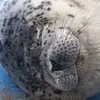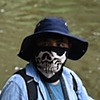HOME | DD
 Fadeno — Deinosuchus hatcheri multiview skeletal
Fadeno — Deinosuchus hatcheri multiview skeletal

#deinosuchus #sarcosuchus #supercroc #hatcheri #purussaurus #riograndensis #alligatoroid #crocodilian
Published: 2020-08-01 20:07:25 +0000 UTC; Views: 39025; Favourites: 315; Downloads: 64
Redirect to original
Description
Skeletal of the great alligatoroid from Campanian Laramidia, Deinosuchus hatcheri. The scale bar is 1 meter long and there are two humans as well. Most of the specimens of Deinosuchus are fairly scrappy, but when all the different remains from across western North America are taken into account, it is actually fairly complete: We have virtually the entire skull and mandibles, most of the cervical and dorsal vertebrae, a ton of osteoderms, quite a bit of the limb girdles, as well as a few ribs, caudal vertebrae, and appendicular elements. The only places I needed to reference other taxa were the limbs and tail; the eastern species of Deinosuchus was used for the leg, pelvis, and caudals, while Alligator mississippiensis filled in the lower arms.Deinosuchus is generally restored as just a gigantic prehistoric crocodile (often based directly on saltwater or American crocodiles), but the real animal is much more interesting. The jaws were very long, like modern gharials or tomistoma, while still being robust. The nasal opening was large and inflated, looking almost like a bowl was imbedded in the animals snout. The tail vertebrae are elongated, even for a crocodilian, while the limbs are a bit shorter than would be expected. The result is a large, stockily-built predator, and the largest individuals were longer and heavier than even Tyrannosaurus rex. Of course, not every individual of Deinosuchus hatcheri was that massive, but we have at least three or four specimens that exceeded 10 meters. A fully grown Deinosuchus of either species was the most massive predator in its environment and that large size gave them a wide menu of possible prey: We have bite marks showing Deinosuchus was regularly going after turtles (primarily large, ocean-going species), hadrosaurs, and even tyrannosaurs!
Methodology
Most of this skeletal is based on one of the largest individuals of D. hatcheri, TMM 43632-1, which preserves quite a bit of skull material, fourteen cervical and dorsal vertebrae (along with other post-cranial remains), several osteoderms and ribs, plus a partial femur, metatarsal, and ankle bone. This is enough to come up with a solid approximation of the snout-to-vent length, which then helped determine the general proportions. The papers describing the holotypes of D. hatcheri and "D. riograndensis" (Holland 1909, Colbert & Bird 1954) have a number of measurements for the vertebrae, skull pieces, shoulder and hip elements, and osteoderms, which were used to help cross scale material from other individuals. While Deinosuchus is an alligatoroid, the caudal vertebrae suggest that it was proportioned like crocodiles, where the tail makes up slightly more than half of the total length of the animal. That being said, large individuals of A. mississippiensis have skull-length to total-body-length ratios of about 1:7-7.5, which is comparable to Deinosuchus. My reconstruction is shorter than the regression-based length estimates from Woodward et al. (1995) and Farlow et al. (2005) based on skull lengths, but is longer than the generalized estimates that place the maximum size of Deinosuchus at 10-12 meters. Most of those estimates are either based on outdated reconstructions or do not explain their methodology, so it is hard to explain why my results differ so much. I do think it is worth noting that my estimate for CM 963 is fairly close to Holland's original estimate of 13.87 meters (based on a comparison of the two vertebrae to extant crocodilians).
There are two sets of mass estimates: the first uses a GDI done by RandomDinos, the second is based on the volume of a 3D model. The results are much larger than most published mass estimates, which generally suggest a mass of about 3-5 tonnes for a 10-11 meter long individual. My estimates are actually fairly close to the numbers you get from isometrically scaling off of living crocodilians, which suggests the published results are much too small (though Schwimmer's estimate of 8 tonnes for a 12 meter long individual wasn't actually that far off). My mass estimate for the Laramidian Deinosuchus is much larger than my estimate for the Appalachian species (by nearly 30%), though this is likely because the most complete specimen of Deinosuchus rugosus/schwimmeri is immature and two thirds the size of the next largest specimen.
One thing to keep in mind is that most of these bones are based on the figures from Cossette 2018 and Cossette & Brochu 2020, and neither of those papers report any measurements (which is why I didn't include any size estimates for the TMM specimens). That isn't a major concern though, as there are enough actual measurements present that scale-bar-based material could just be scaled to match the measurements of the larger but less complete individuals. Interestingly, neither of those papers figure any of the mandible fragments associated with TMM 43632-1 that Farlow et al. used for their skull estimate, but do figure tons of other bones that Farlow et al. don't mention, including a decent amount of skull material and a nearly complete presacral vertebrae series (which you think would have come in handy for producing and checking their estimates). Farlow et al. also used a much shorter femur length than I got from using Cossette and Brochu's figure, but the femur is broken in the middle. The length used Farlow et al. makes sense if you assume there was no missing material, but the two halves don't line up and without measurements of the preserved sections it isn't clear if my hunch is correct.
Regardless of how large TMM 43632-1 is, the estimates for CM 963 are based on actual measurements, and thus are unlikely to change significantly. I talk much more about the methodology behind these estimates on the skull chart, so go check that out for more detail. The to see how the different individuals stack up check out my Deinosuchus skull chart. I also have a multiview skeletal for the Appalachian species which you can see here and you can see a comparison of the largest individuals of the two species here (outdated).
References
Chabreck, R.H., Joanen, T. 1979. "Growth Rates of American Alligators in Louisiana" Herpetologica. 35 (1)
Colbert, E.H., Bird, R.T. 1954. "A gigantic crocodile from the Upper Cretaceous beds of Texas" American Museum Novitates. 1688: 1–22.
Cossette, A.P. 2018. "A Systematic Review of the Giant Alligatoroid Deinosuchus from the Campanian of North America and Its Implications for the Relationships at the Root of Crocodylia" The early history of character evolution in alligatoroids. Ph.D dissertation, University of Iowa.
Cossette A.P., Brochu C. 2020. "A systematic review of the giant alligatoroid Deinosuchus from the Campanian of North America and its implications for the relationships at the root of Crocodylia", Journal of Vertebrate Paleontology, DOI: 10.1080/02724634.2020.1767638
Farlow, J.O., Hurlburt, G.R., Elsey, R.M., Britton A.R.C., Langston Jr, W. 2005. "Femoral dimensions and body size of Alligator mississippiensis: estimating the size of extinct mesoeucrocodylians". Journal of Vertebrate Paleontology. 25 (2)
Holland, W.J. 1909. "Deinosuchus hatcheri, a new genus and species of crocodile from the Judith River beds of Montana." Annals of the Carnegie Museum. vol. 6, pp. 281- 294.
Irmis R.B., Hutchison J.H., Sertich J.J.W., Titus A.L. 2013. "Crocodyliforms from the Late Cretaceous of Grand Staircase-Escalante National Monument and vicinity, southern Utah, U.S.A." Titus A.L., Loewen M.A., eds. At the Top of the Grand Staircase: The Late Cretaceous of Southern Utah. Bloomington: Indiana University Press, 424–444.
Klinkhamer, A.J., Wilhite, D.R., White, M.A., Wroe, S. 2017. "Digital dissection and three-dimensional interactive models of limb musculature in the Australian estuarine crocodile (Crocodylus prorosus)." PLoS journals.plos.org/plosone/arti…
Larramendi, A, Paul, GS, Hsu, S. 2020. "A review and reappraisal of the specific gravities of present and past multicellular organisms, with an emphasis on tetrapods." Anat Rec. 2021; 304: 1833– 1888. doi.org/10.1002/ar.24574
Lucas, S.G., Sullivan, R.M., Spielman, J.A. 2006. "The Giant Crocodylian Deinosuchus from the Upper Cretaceous of the San Juan Basin, New Mexico." Lucas, S.G., Sullivan, R.M. eds. New Mexico Museum of Natural History and Science Bulletin. 35
Rivera-Sylva, H. E., Frey, E., Guzmán-Gutierrez, J. R., Palomino-Sánchez, F., & Stinnesbeck, W. 2011. Un Deinosuchus riograndensis (Eusuchia: Alligatoroidea) de Coahuila, norte de México. Revista mexicana de ciencias geológicas, 28(2), 267-274. www.scielo.org.mx/scielo.php?p…
Scheyer, T.M., Hutchinson, J.R., Strauss, O., Delfino, M., Carrillo-Briceño, J.D., Sánchez, R., & Sánchez-Villagra, M.R. 2019. "Giant extinct caiman breaks constraint on the axial skeleton of extant crocodylians". eLife, 8, e49972.
Schwimmer, D.R. 2002. King of the Crocodylians: The Paleobiology of Deinosuchus. Indiana University Press ISBN 978-0-253-34087-0 .
Titus, A.L., Knell M. J., Wiersma, J.P., Getty, M.A., 2008 "First Report of the Hyper-Giant Cretaceous Crocodylian Deinosuchus from Utah." Geological Society of America conference. web.archive.org/web/2017072921…
Update Log
(11/1/2021) Updated to the new skeletal and mass estimates, there will be more updates to various Deinosuchus stuff in the coming days.
(8/5/2020) Updated the pelvis based on material from the Appalachian species of Deinosuchus, as well as lowering the limbs a bit. Also changed the angle on the front limbs on the dorsal view.
(9/1/2020) Rescaled the arm and tweaked the silhouette. Also updated the mass estimates based on my GDI and rewrote the mass section of the methods to accommodate that.
(10/19/2020) Fixed the articulation of the chest, which lowered the mass estimates a bit. Also made some updates to the skull.
(1/11/2020) Accidently updated the image early, but here's the (somewhat) big overhaul. Reworked the pelvis, leg, and unpreserved caudal vertebrae based on the Deinosuchus rugosus/schwimmeri diagram, updated the front views to account for changes to the skull and the outline that were made while working on the walking version, and finally redid the GDI (with an osteodermless-outline). This is ideally the final, definitive update unless I do something crazy like a full ventral reconstruction or we get a better description of the TMM material (or a larger specimen shows up).
Related content
Comments: 44

👍: 0 ⏩: 0

👍: 2 ⏩: 0

👍: 0 ⏩: 0

👍: 0 ⏩: 0

👍: 1 ⏩: 1

👍: 2 ⏩: 0

👍: 0 ⏩: 0

👍: 1 ⏩: 2

👍: 2 ⏩: 0

👍: 4 ⏩: 0

👍: 1 ⏩: 1

👍: 1 ⏩: 1

👍: 0 ⏩: 1

👍: 0 ⏩: 0

👍: 0 ⏩: 1

👍: 3 ⏩: 2

👍: 0 ⏩: 1

👍: 1 ⏩: 0

👍: 0 ⏩: 0

👍: 1 ⏩: 1

👍: 1 ⏩: 1

👍: 1 ⏩: 1

👍: 1 ⏩: 1

👍: 2 ⏩: 0

👍: 0 ⏩: 1

👍: 0 ⏩: 0

👍: 1 ⏩: 2

👍: 0 ⏩: 0

👍: 1 ⏩: 1

👍: 0 ⏩: 1

👍: 0 ⏩: 0

👍: 0 ⏩: 1

👍: 0 ⏩: 1

👍: 0 ⏩: 0



















